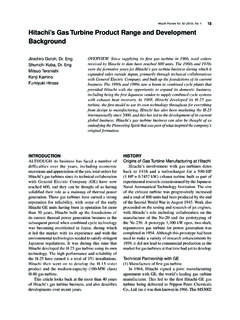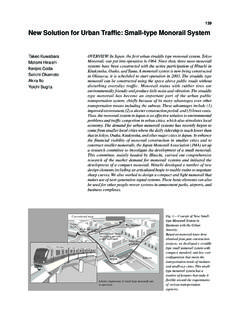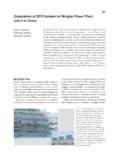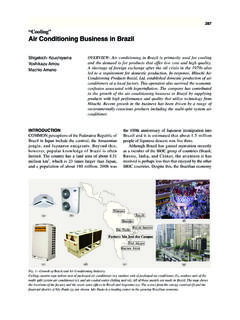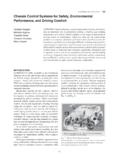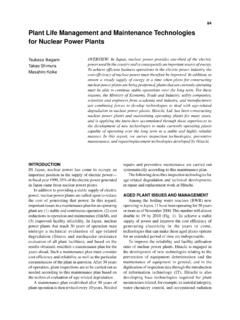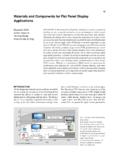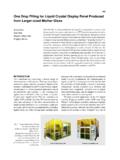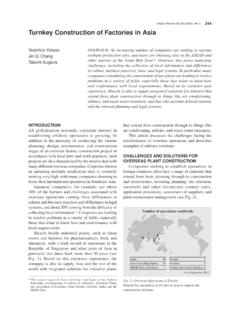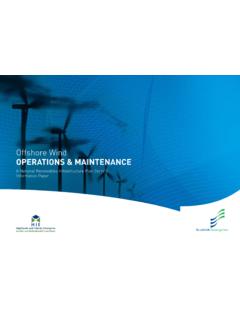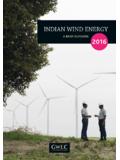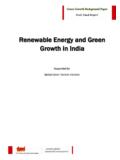Transcription of Development of 5-MW Offshore Wind Turbine …
1 Hitachi Review Vol. 63 (2014), No. 7 414 - 47 -Featured ArticlesDevelopment of 5-MW Offshore wind Turbine and 2-MW Floating Offshore wind Turbine TechnologyMitsuru SaekiIkuo TobinagaJunichi SuginoTakashi ShiraishiOVERVIEW: To date, Hitachi has received orders for a total of 137 of the 2-MW downwind turbines it developed for use in Japan s demanding conditions such as tyhoon gusts and wind turbulance in its mountainous regions. The first seven Offshore wind turbines mounted on fixed seabed foundations to be built in Japan commenced operation in 2010, with an additional eight turbines added in 2013. Hitachi is now drawing on this experience to develop a 5-MW downwind Turbine for Offshore use. Hitachi has also, as a member of the Fukushima Offshore wind Consortium, supplied a wind Turbine to the Fukushima Floating Offshore wind Farm Demonstration Project sponsored by the Ministry of Economy, Trade and Industry.
2 Similarly, it has installed a 2-MW downwind Turbine for the Floating Offshore wind Turbine Demonstration Project led by the Ministry of the Environment, with Hitachi being part of the group contracted to undertake the forms of renewable energy are being developed and commercialized around the world in response to the increasing environmental demands that accompany progress. Of these, wind power generation, in particular, has reached a stage where its output and cost are close to traditional forms of power generation using fossil fuels and nuclear power. It is growing in both scale and sophistication, being installed at various places around the world, not only in Europe, which is the leading early adopter of the began developing its 2-MW downwind Turbine in 2003, using the SUBARU22/100 to conduct quantitative testing of the differences between upwind and downwind configurations(1).
3 Subsequently, seven Offshore wind turbines built on fixed seabed foundations, Japan s first, commenced operation in 2010(2), with an additional eight wind turbines entering service in 2013. Drawing on this experience, Hitachi is now developing the , a 5-MW downwind Turbine for Offshore a maritime nation, Japan is surrounded by large areas of ocean that have much greater potential for wind power generation than on land. However, if wind turbines are to be situated Offshore , they need to be capable of generating power reliably from floating platforms ( floaters ) without fixed seabed foundations. Hitachi has supplied one to the Fukushima Floating Offshore wind Farm Demonstration Project sponsored by the Ministry of Economy, Trade and Industry, and another to the Floating Offshore wind Turbine Demonstration Project led by the Ministry of the Environment.
4 Through this testing, Hitachi aims to verify the viability of floating Offshore wind power m126 mFig. 1 wind has a rotor diameter of 126 m and is designed to withstand gusts of 70 m/s or Development of 5-MW Offshore wind Turbine and 2-MW Floating Offshore wind Turbine Technology- 48 -This article describes the concept and features of the , the differences between mounting wind turbines on floaters and on fixed seabed foundations, an overview of two floating wind power generation systems, and the progress that has been made on testing these 5-MW DOWNWIND Offshore wind POWER GENERATION SYSTEMIn response to demand for larger Offshore wind power generation systems, Hitachi plans to build a prototype of its 5-MW downwind Offshore wind power generation system off the coast of Kamisu City in Ibaraki Prefecture. Fig. 1 shows a drawing of the prototype, Table 1 lists its specifications, and Fig.
5 2 shows its power to locations such as Europe s North Sea, Japan and nearby parts of Asia have not only a low mean wind speed in the 6 to 8 m/s range, but also experience gusts of up to 70 m/s during specifications of the were chosen to achieve good economics, reliability, durability, and scope for future expansion under these conditions. The rated capacity for the wind Turbine was set at 5 MW because this allows monopile foundations, which is the lowest cost option, to be used. Use of a two-stage gearbox is being considered to reduce the weight of the tower head. The target weight of the tower head is 350 t. Fig. 3 shows the nacelle of Downwind TurbinesA major feature of the is that the rotor is located on the downwind side of the tower. This configuration ensures high reliability in environments such as Japan, where typhoons are frequent, even during power outages on the grid(3).
6 Because the large rotor required for higher wind Turbine capacity means greater bending, locating the rotors on the downwind side eliminates the risk of bending causing the rotor to collide with the tower, facilitating the adoption of larger rotor diameters by minimizing the restrictions associated with longer rotor blades. Furthermore, the clearance between the blades and tower increases with increasing wind speed on a downwind Turbine . Compared to an upwind configuration, where the opposite occurs, this improves safety by further reducing the potential for a collision between tower and blade(4).ParameterSpecificationRated output5,000 kWRotor diameter126 mHub height90 m or more Number of blades3 Rotor orientationDownwindTilt angle 8 Coning angle5 Output controlPitch, variable speedBrakeBlade feathering (independent pitch)Yaw controlNormal operation: Active yawWhen shutdown in high winds: Free to rpm (min-1)Gear ratio1:40 (approx.)
7 GeneratorPermanent magnet synchronous generatorPCSFull converterTurbine output voltage33,000 VCut-in wind speed4 m/sCut-out wind speed25 m/sTABLE 1. SpecificationsAn output voltage of 33 kV was selected to improve the economics of the undersea cable used to connect to the onshore : power conditioning systemOutput (kW)6,0005,0004,0003,0002,0001,000001020 wind speed (m/s)30 Fig. 2 Power wind Turbine has a capacity of 5 MW and uses monopile foundations, which have the lowest drivemechanismHubFrameGearboxGeneratorNa celle controlboardRadiator coolerFig. 3 Nacelle nacelle has a two-stage gearbox to reduce weight and improve Review Vol. 63 (2014), No. 7 416 - 49 -The stability of the downwind configuration is also potentially valuable for floating Offshore wind power generation, and it provides major benefits to the two floating Offshore wind power generation systems described later in this ImprovementsBecause Offshore wind turbines are more difficult to access than land-based installations, they need to achieve higher utilization than on land in order to improve the economics of Offshore wind turbines over their entire lifetime(5).
8 This means they require higher it was designed specifically for Offshore use, Hitachi has already incorporated, or is considering incorporating, a number of reliability improvements in the The following sections describe the most important of these.(1) Medium-speed gear driveTo reduce the potential for faults in the gearbox and generator, Hitachi is considering adopting a medium-speed gear drive consisting of a gearbox (with a gear ratio of approximately 1:40) in place of parallel gears, along with a 36-pole permanent magnet synchronous generator.(2) Dual-bearing outer ring driveHitachi is considering the use of a dual-bearing outer ring drive system on the in order to bear the higher loads associated with larger wind turbines (see Fig. 4). This system uses two shafts (fixed and rotating) to split the rotor load and transmit it to the rest of the structure.
9 This design improves the reliability of the gearbox by transmitting a very pure torque load to it, with minimal loading other than the rotor torque component. Also, because the fixed shaft that bears loads other than torque does not itself rotate, it improves the reliability of structural components by reducing the fatigue load.(3) Passive coolingBecause the has a downwind configuration, the front side of the nacelle is the part that is furthest upwind. Hitachi has utilized this feature to incorporate a passive (fan-less) cooling system. Using computational fluid dynamics, it has designed the important parts of the nacelle shape to ensure the volume of air necessary for cooling (see Fig. 5). Development ScheduleThe prototype is currently being fabricated and is expected to be ready for construction in the summer of 2014. The power train is undergoing full power testing at the factory prior to nacelle 6 shows an overview of full power testing, which includes measuring the power train behavior BearingRotating partsFixed partsFig.
10 4 Dual-bearing Outer Ring of separate fixed and rotating shafts splits the rotor load and transmits it to the rest of the 5 Fluid Dynamics Simulation around figure shows a simulation of air flow through the radiator used in the design of the nacelle train(testing scope)Regenerativeelectric powerBusbarInverterMotorDriveLoad23 m(approx.)ReductiongearGeneratorGearboxP CSR otatingshaftFig. 6 Full Power Testing of Drive power trains were installed and tested using electric power Development of 5-MW Offshore wind Turbine and 2-MW Floating Offshore wind Turbine Technology- 50 -under variable torque and with alignment deviations. Fig. 7 shows the test apparatus with which full power testing is FLOATING Offshore wind FARM DEMONSTRATION PROJECTO verview of Fukushima Offshore Floater ProjectThe Fukushima Offshore wind Consortium made up of Marubeni Corporation (as project integrator), ten companies (including Hitachi), and The University of Tokyo (as technical advisor) was contracted by the Ministry of Economy, Trade and Industry in March 2012 to undertake the Fukushima Floating Offshore wind Farm Demonstration Project.
